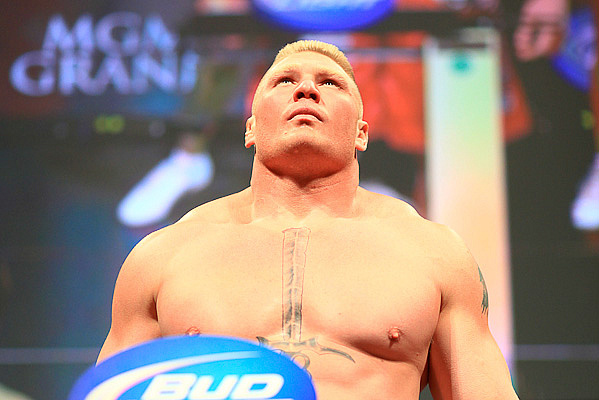Fistic Medicine: Top Stories of 2010
Matt Pitt Jan 8, 2011

Brock Lesnar | Sherdog.com
In lieu of a recap of the year’s grimmest injuries -- a task beyond both this column’s mandate and this writer’s abilities -- we offer Fistic Medicine’s Top Stories of 2010.
The Contenders
Advertisement
Perhaps the most famous colon in sports. Certainly among the largest.
From Fistic Medicine’s perspective, the most exciting battle in
Brock
Lesnar’s career -- with apologies to Shane
Carwin, Cain
Velasquez and The Undertaker -- was Pfizer vs. Bacteroides
fragilis. B. fragilis, of course, is one of the bacteria
responsible for invading and perforating the wall of Lesnar’s
colon. Well out of Lesnar’s weight class -- in the extremely
lightweight one femtogram (0.0000000000000001 kilogram) division --
the bacteria came close to permanently retiring the heavyweight.
Pfizer -- fighting out of the Western Medicine Fighting Academy --
is the maker of Flagyl, one of the top pound-for-pound antibiotics
in the armamentarium of modern medicine. This time, the victory
went to Pfizer. With the rise of antimicrobial resistance, the
rematch is sure to be exciting.
Despedida ‘Minotauro’?
There have been worse knockouts in 2010, but none more ominous.
As Sherdog’s Greg Savage says, knockouts are like erectile dysfunction: it can happen once to anyone, and there’s always an excuse, but the second time it happens, you can’t help but worry. Nogueira has faced powerful punchers before and weathered brutal beatings, yet he has been knocked out more in his last three fights than in his previous 36 fights combined. Something has happened. Some may wish to blame age, but Noguera is 34 -- 33 at the time of the Velasquez knockout -- hardly an old man. One cannot help but suspect that the powerful punchers and brutal beatings of the last decade have left their mark. How many knock outs will it take for UFC President Dana White to call for this warrior’s retirement?
$300 to Fight, Five Children
There is no Fistic Medicine article on the death of Michael Kirkham. A.J. Perez has done the job as well as it can be done: http://www.mmafighting.com/2010/07/15/death-in-the-cage-the-michael-kirkham-story/.
Whose responsibility is fighter safety? The fighter’s? Sure. The promoters? Of course. The state athletic commission? What else does it exist for? It may be that Kirkham’ death was unpreventable, but it is difficult to take such a claim seriously in the absence of evidence that any serious effort at prevention was made. Tragedies such as the death in the ring of a fighter can either prompt serious efforts to advance safety or meaningless cosmetic changes to appease a sickened public. Too often, fight sport has opted for the latter.
Carlos Iraburo, Kirkahms opponent that night, was overwhelmed.
“I got really emotional and thought, ‘What have I done?’” he said. “I have to admit, it’s not an easy feeling. I’m going to be messed up inside for a while.”
If promoters and athletic commissions felt this way when a fighter died, our sport would be different -- and better.
17 Miles to the Hospital, One hour
There is no Fistic Medicine article on the death of Adrienne Simmons. Jake Rossen has done the job as well as it can be done: /news/articles/Another-Death-Another-Lesson-for-Combat-Sports-25939.
The details change, but the fundamentals remain inviolate. Another disinterested promoter. Another death.
Couture vs. Toney: Too Young for MMA?
When Randy Couture faced off against James Toney at UFC 118 in August, the combined ages of the men in the ring was 89. Fans of Dr. James Williams are forced to question whether competitive MMA can be safely undertaken by such relatively young and inexperienced athletes.
When Dr. Williams, 70, and Larry Brubaker, 49, faced off in an Elite 1 MMA Productions “Wild Card” fight on July 24, they set the world record for total age of combatants in an MMA ring. If one posits that the legitimacy of fight sport is a function not of sex or age but of an athlete’s autonomy -- his or her freedom not to fight should they so choose -- then perhaps a fight between older men not coerced by the pressures of making a career or supporting a young family is the most legitimate form of MMA. Perhaps not. That discussion is better left to a Fistic Philosophy column.
The interest of this column is the lengths to which the promoter went to ensure the fighters’ safety. The bout used the International Modified Rules for MMA -- barring elbows -- and the combatants used extra-padded gloves and shin guards. Prior to competing, each fighter underwent extra physical exams, an MRI of the brain and cardiac stress tests. An EMT unit was on scene. The degree of pre-fight caution suggests a promoter who cared about his fighters beyond their mere earning potential; the promoter was Steve Williams, Dr. Williams’ son.
The Champion
Chris Henry, Cincinnati Bengals
Why is the biggest medical story in MMA about an NFL athlete? Because as different as the two sports are, the brains of the athletes who compete in them look suspiciously similar under the microscope.
Chris Henry, NFL wide receiver, died accidentally at the age of 28; at autopsy, his brain showed evidence of Chronic Traumatic Encephalopathy. Everyone in the NFL tasked with addressing the issue of CTE took note, and that’s good for the sport of MMA and the fighters we admire. What happens in MMA, and to MMA athletes, can be ignored by most of America, but If the NFL leads the way and sets the standard for protecting its athletes, MMA will follow.
Based on this criterium -- the hope that catastrophe will lead to change -- there can be no bigger story from 2010.
Related Articles






